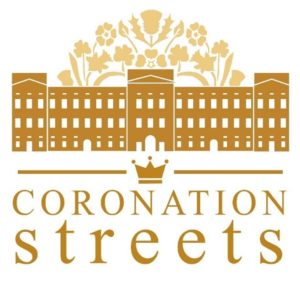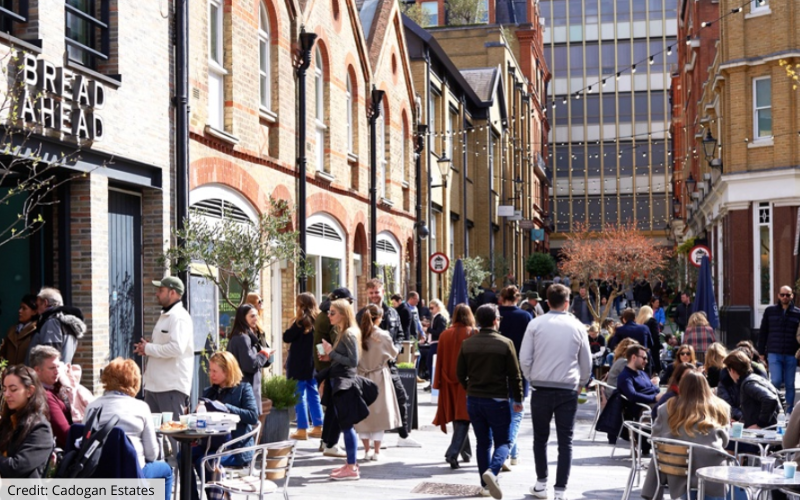There was nothing wrong with Pavilion Road ten years ago, a mews just off Sloane Square. On the other hand, there was little assertively right about it: a potpourri of converted Victorian stables, parked cars, crude tarmac and some charmless but inoffensive 1960s flats.
PG Wodehouse once wrote of a similar (fictional) street off Leicester Square, ‘Of all the spots in London which may fairly be described as back-waters, there is none that answers so completely to the description…Day and night the human flood roars past, ignoring it.’ But now, the human flood roars into Pavilion Road not past it. What has happened? And how?
Pavilion Road is in our mind at Create Streets because it won third prize (and the highest scoring London street) in our recent ‘Coronation Streets Competition’, a light hearted online poll in joint celebration of the King’s Coronation and the first decade of Create Streets’ existence.

Pavilion Road, 2012 (Google Maps Street View)

Pavilion Road, 2023 (Google Maps Street View)
Which of Britain’s streets was the most beautiful, we asked. Which has the strongest neighbourhood or community? Which provides the best setting for connected and sociably lives? Where do you like to go?

We received 1,406 votes and nominations for Britain’s best street. There were some discernible themes in the streets people nominated and voted for. All were old, attractive and safely walkable. None were dominated by cars. Featureless facades and metronomic spreadsheet architecture are not the settled will of the British people. This was not a controlled study but the preference of the votes we received corroborate with the preferences revealed in many dozens of visual preference surveys and academic studies.
However, this does not preclude change. All our wining streets have changed a lot over the centuries. But they have done so in ways that preserve or even enhances their “streetiness.”
Our third placed street, Pavilion Road, has recently been lovingly and carefully ‘reinvented’ from a back street with a few homes to a vibrant place to shop and dine. An absolute masterpiece of urban acupuncture overseen by landowners, the Cadogan Estate, who take their stewarding carefully. What was once the longest mews in London is now rediscovered as a lively and fashionable hub for residents and visitors, shopping and strolling, buying and dining.
Pavilion Road, initially the New Road, was a narrow mews street built behind Sloane Street, completed to the plans of the Cadogan Estate architect, Henry Holland in 1788 when the first of its 44 homes were leased out. ‘Pavilion’ was a reference to Henry Holland’s neoclassical work for the Prince Regent at the Brighton Pavilion, now largely effaced by John Nash’s subsequent Indo-Islamic fantasy. Just as narrow Pavilion Road was subservient to wider Sloane Street so, for over 200 years, Pavilion Road was a home to the servants, workshops, horses and coachmen who serviced Knightsbridge’s rich elite. By the late twentieth century (no horses and far fewer servants) the mews had evolved into a street to park cars and for small homes for those who aspired to a Sloane Street address but whose budgets did not quite stretch to Sloane Street mansion blocks.
The Cadogan Estate, still the largest landowner after over 300 years, had a rare modern opportunity to create a new building due to the presence of two unlisted and loveless ugly 1960s blocks on Sloane Street: grey, repetitive and horizontal they were gratuitous in their careless disdain for the Sloane Street’s colours, playfulness and vertical rhythm. George House, which has replaced them is far from perfect but is a huge improvement and much less offensive: a spreadsheet of ochre-hued Scottish Locharbriggs sandstone, the façade undulating gently along the street, waxing and waning, bay by bay. Critically, with six storeys George House is also much bigger and more profitable thus funding a series of improvements to Pavilion Road behind.
Encouraged by local residents’ feedback, in 2016 the Estate created a plan for a new local village ‘high street.’ This was despite local planning policy favouring primarily residential uses. It had seven key components.
- A building facing two ways. Creating the new George House with a ‘back’ as well a ‘front’ facing onto;
- A new public space instead of the former private service yard with;
- Greening-up. Generous provision of new plants and greenery in the public space;
- New shops replacing some of the former 1960s homes and lovingly evolving the local architectural vernacular (only one 1980s home that would have been nice to keep was lost);
- Gentle restoration of the existing buildings, re-purposing them for the next 100 years;
- ‘Curating’ tenants to be independent retailers and restaurants not chain stores; and
- Pedestrianising Pavilion Road to clean the air and encourage more shopping and dining.
Pedestrianisation was granted in 2021.And the street is palpably flourishing. There were an astonishing 10 million visitors in 2022. Over 100 people are employed on the street. Pavilion Road is doing everything that the local residents consulted hoped that it would.
It is a case study in the Create Streets approach not just to the process but to the outcome of street-design and stewardship. Repurposing existing buildings wherever possible. Keeping the attractive. Losing the ugly. Making it easy and tempting to live and shop locally. Encouraging streets in which it easy and natural to live and work, walk and shop.
Money helps of course. George House helped fund investment. And Pavilion Road is in a neighbourhood, well-located and rich in social and monetary capital. So does stewardship. Most neighbourhoods don’t have the privilege of landowners looking hundreds of years into the future.
Surely regenerative development here should be easy? It is certainly easier. But the ‘tricks’ pulled here are, for all the gloss and sheen of Knightsbridge, the same tricks of humanity, and attraction, mixing and mingling that work from Cornwall to Cumbria. Other less privileged London and British streets and places can do the same.
For example, in 2010 Altrincham’s town centre was in deep decline, widely regarded as a ‘ghost town’ and with 30 per cent of its shops unoccupied (the highest level in England at the time). However, by November 2018 the Great British High Street awards, was able to declare it the best high street in the country. This dramatic change was effected in large by the local community of shopkeepers and residents taking control: creating the ‘Altrincham partnership’, forming a Neighbourhood Forum and writing a neighbourhood plan. Put simply this plan made the town centre a place you would want to be and go: part-pedestrianising it, creating a tree-lined boulevard, restoring a covered market, making loans to independent stores, re-creating homes above shops, and encouraging a wide variety of independent as well as chain shops as well as cinemas and a library.
Exmouth Market in Clerkenwell has been transformed since the 1990s thanks to local landowners, the Debenham Property Trust, actively granting leases not to chain stores but to independent stores: the whacky and the wonderful, maybe sacrificing some retail rents but making it back elsewhere in residential or commercial rents. Meanwhile, Islington Council pedestrianised the street and improved the paving and street furniture. The street now buzzes as it never did a generation ago.
Similar things are happening in Coventry’s high street, Letchworth’s city centre, Stoke Newington’s Church Street and many others both within and beyond London. In each, the precise journey has been different and less prosperous places need more public sector investment and risk-taking. But the themes are continuous: stewardship and street trees, understanding what people like, community action, empowering neighbourhood preferences, making safe and attractive places to walk and work, live and shop.
The moral? If you love a street, it will love you back.
Nicholas Boys Smith is the director of Create Streets. His history of London’s streets, No Free Parking, was published in paperback by Bonnier books on 22 June.


